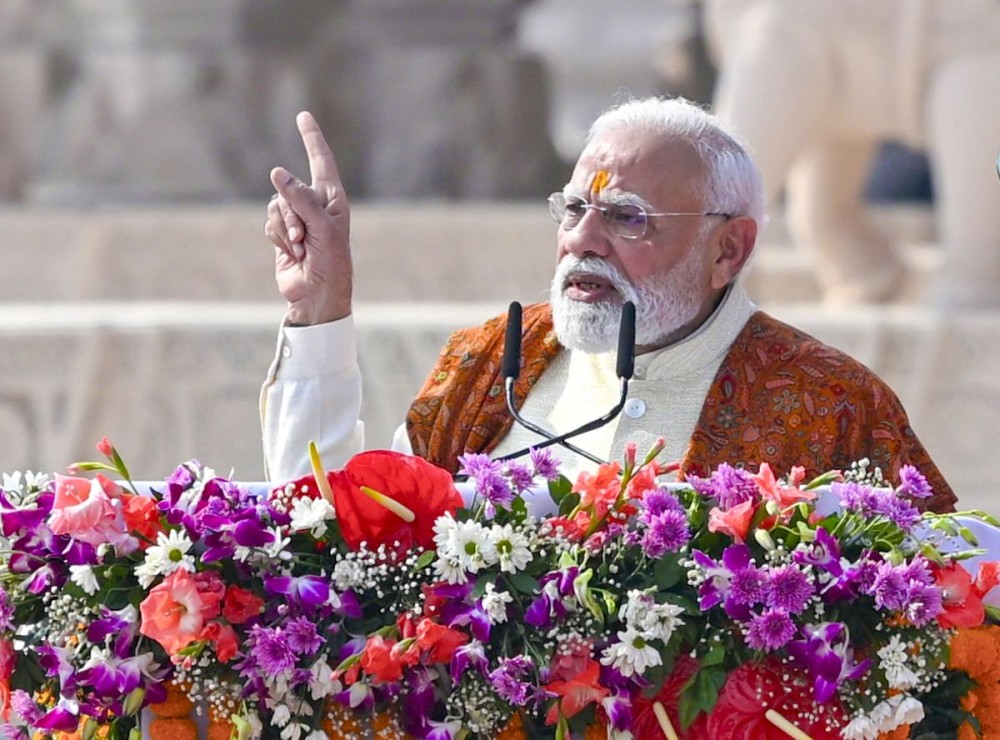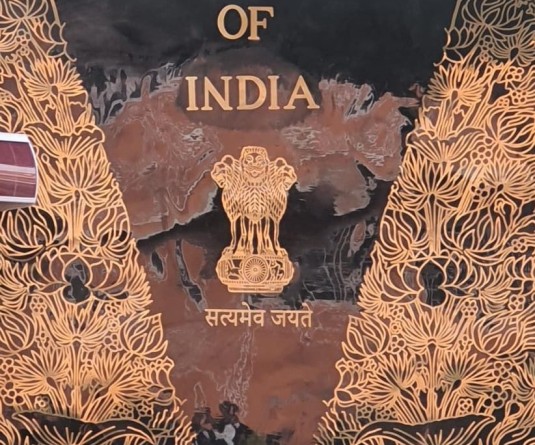Ayodhya: Prime Minister Narendra Modi addresses the Dhwajarohan ceremony to ceremonially to hoist the saffron flag on the Shikhar of the sacred Shri Ram Janmabhoomi Temple, symbolising the completion of the temple’s construction, in Ayodhya, Tuesday, November 25, 2025. (Photo: IANS/PMO)

New Delhi, November 25 (IANS) Prime Minister Narendra Modi had made a promise to the people of India -- of returning the childhood abode of Lord Ram to its historic glory.
Around noon on Tuesday, that promise was delivered when he unfurled the saffron flag atop the newly built Ram Mandir in Ayodhya.
It marked the completion of the temple's construction where the Prime Minister had himself laid its foundation stone on August 5, 2020.
"Today, the city of Ayodhya is witnessing yet another pinnacle of India's cultural consciousness. This moment of the flag hoisting ceremony on the tower of Shri Ram Janmabhoomi Temple is unique and divine," said PM Modi, hailing Lord Ram and wife Goddess Sita.
"This religious flag is not just a flag... it is the flag of the renaissance of Indian civilisation," he also said in his address.
He unfurled the right-angled triangular flag, which, according to an official statement, measures 10 feet in height and 20 feet in length, and bears the image of a radiant Sun symbolising the brilliance and valour of Lord Ram.
"This flag is a symbol of Lord Ram's radiance, valour and his ideals, as well as our faith, spirituality and cultural heritage," he had written in an X post a day before the event.
It was raised atop the 191-foot shikhar -- the highest point -- or the peak of the temple on a day that coincided with Vivah Panchami, celebrating Lord Ram and Goddess Sita's marriage.
The event was also attended by Uttar Pradesh Governor Anandiben Patel, Rashtriya Swayamsevak Sangh Chief Mohan Bhagwat, and Uttar Pradesh Chief Minister Yogi Adityanath, underscoring its significance.
By hoisting the saffron dhwaj, PM Modi positioned himself not just as a political leader but as a custodian of Hindu civilisational aspirations.
It was a moment layered with history, politics, and symbolism -- a culmination of centuries of religious contestation, decades of political mobilisation, and a reassertion of cultural nationalism.
The act resonated far beyond Ayodhya, shaping India's identity narrative at home and abroad.
As PM Modi asserted, "If India is to become developed by 2047... If society is to be empowered... Then we must awaken the 'Ram' within ourselves," adding, "If the nation has to move forward, it will have to take pride in its heritage."
Incidentally, The Ram Mandir movement has been one of the most defining socio-political struggles in modern India.
The Babri Masjid, built in 1528, stood at the site Hindus revered as Lord Ram's birthplace.
Its demolition in 1992 by "kar sevaks" triggered communal riots, leaving scars on India's secular fabric.
Finally, the Supreme Court's 2019 verdict awarding the land to Hindus marked a legal closure to the dispute.
The long wait for Lord Ram's return to the Ayodhya site culminated with the PM's 'bhoomi pujan' in 2020 that symbolised the beginning of temple construction, and now, the unfurling of the flag represents its consecration.
The temple's completion transforms Ayodhya into a pilgrimage hub.
Millions are expected to visit annually, boosting tourism and local economy.
For many Hindus, the saffron flag represents a resurgence of pride after centuries of perceived subjugation.
Investments in Ayodhya reflect regional growth with airports, highways, hotels, and railways being developed to accommodate pilgrims as more and more devotees and tourists are expected to reach here in the coming years.
Globally, the event resonates with the Hindu diaspora, reinforcing India's role as the spiritual homeland.
The Ram Mandir becomes not just a local shrine but a global symbol of Hindu identity.
The temple thus becomes both a spiritual and economic engine, reshaping Ayodhya's destiny.






